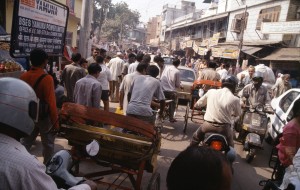5.3% is Failure
Full disclosure: this hits close to home for me. As an Indian citizen, I’d be lying if I said that the last five years didn’t carry a tinge of pride. Consistent 8% growth, a booming services and telecom sector, and, most importantly, a retention of the country’s most important democratic institutions, painted a rosy picture of the future. The bubble, however, has been burst: the latest GDP growth figures are out, and India’s economy is growing at 5.3 %. Compared to the 3% that the U.S manages, this might not seem so bad, but when viewed in light of the country’s vast economic potential and its current poverty, this represents an enormous failure of politics.
Since 1947, the country has broadly known two types of economic policy. From independence until 1991, it was driven by a socialist-inspired central planner approach, complete with five-year plans and vast amounts of red tape. An economic crisis in the late eighties led to the opening of the country’s economy in 1991, and planted the seed for the kind of growth the country has enjoyed in the last few years. The growth was not without its pitfalls; inequality has been exacerbated, and wealth has not quite trickled down, but the basic argument remains that a country needs a combination of wealth and good policy (access to health and education among other thing) to create social mobility. Liberalization–itself a good policy– created the former, but there is a long way to go yet.
The red tape diminished, but did not go away, and corruption remained a huge roadblock on the road to economic success. However, a vigorous entrepreneurial class made the most of their new-found access to capital in the nineties and many of them, like Reliance and Wipro, became multi-billion dollar companies. Overwhelmingly, though, the story has been of industries thriving in spite of the government, and already, it seems as if the country is turning its back on foreign investors.
The fundamental problem is a stalled government. The ruling Congress party, in power since 2004, is holding together a motley coalition that is bursting at the seams. The proliferation of smaller, regional parties, each with their own agenda, has only made a national outlook and approach more difficult. A series of crippling corruption scandals has weakened its influence. The ineffectiveness couldn’t have been worse timed: inflation has significantly weakened the rupee, leading to a surge in petrol prices; simultaneously, a borrowing binge has meant that debts are approaching a tenth of GDP, crowding out private enterprise (this isn’t quite something to be concerned about yet; what’s worrying is how quickly that’s increasing).
In 2008, when the Congress won the general election, it declared that the people of India had given it a mandate. Four years on, the report card is out, and makes for depressing reading. The people deserve better.
